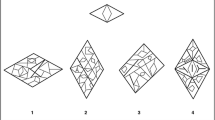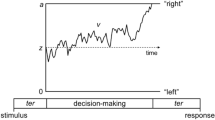Abstract
Children diagnosed with Pervasive Developmental Disorder Not Otherwise Specified (PDD-NOS) and Asperger Syndrome (AS) may be characterised by a similar perceptual focus on details as children with autistic disorder (AD). This was tested by analysing their performance in a visuoperceptual task [the Children’s Embedded Figure Test (CEFT)] and a graphic reproduction task [the Rey Complex Figure Task (Rey CFT)]. Control groups were children with Tourette Syndrome (TS) and typically developing children. The TS sample performed similarly to the normal control group in both tasks. The CEFT results did not show the expected preference for local processing in children with PDD-NOS. However, the Rey CFT data revealed that the children with this lesser variant of PDD processed visuospatial information in a fragmented way and were deficient in global processing.






Similar content being viewed by others
References
American Psychiatric Association. (1994). Diagnostic and statistic manual of mental disorders (4th ed.). Washington, DC: American Psychiatric Association.
Baron-Cohen, S., & Jolliffe, T. (1997). Another advanced test of theory of mind: evidence from very high functioning adults with autism or Asperger syndrome. Journal of Child Psychology and Psychiatry, 38, 813–822.
Booth, R., Charlton, R., Hughes, C., & Happé F. (2003). Disentangling weak coherence and executive dysfunction: Planning drawing in autism and attention-deficit/hyperactivity disorder. Philosophical Transactions Royal Society London: Biological Sciences, 358(1430), 387–392.
Bonnel, A., Mottron, L., Peretz, I., Trudel, M., Gallun, E., & Bonnel, A.M. (2003). Enhanced pitch sensitivity in individuals with autism: A signal detection analysis. Journal of Cognitive Neuroscience, 15, 226–235.
Brian, J. A., & Bryson, S. E. (1996). Disembedding performance and recognition memory in autism/PDD. Journal of Child Psychology and Psychiatry, 37, 865–872.
Brian, J. A., Tipper, S. E., Weaver, B., & Bryson, S. E. (2003). Inhibitory mechanisms in autism spectrum disorders: Typical selective inhibition of location versus facilitated perceptual processing. Journal of Child Psychology and Psychiatry, 44, 552–561.
Brosnan, M. J., Scott, F. J., Fox, S., & Pye, J. (2004). Gestalt processing in autism: Failure to process perceptual relationships and the implications for contextual understanding. Journal of Child Psychology and Psychiatry, 4, 5459–5469.
Buitelaar, J. K., & van der Gaag, R. J. (1998). Diagnostic rules for children with PDD-NOS and Multiplex. Developmental Disorder. Journal of Child Psychology and Psychiatry, 39, 911–919.
Buitelaar, J. K., van der Gaag, R. J., Klin, A., & Volkmar, F. (1999). Exploring the boundaries of pervasive developmental disorder not otherwise specified: Analyses of data from the DSM-IV Autistic Disorder Field Trial. Journal of Autism and Developmental Disorders, 29, 33–43.
Chakrabarti, S., & Fombonne, E. (2001). Pervasive developmental disorders in preschool children. Journal of the American Medical Association, 285, 3093–3099.
Filipek, P. A., Accardo, P. J., Baranek, G. T., Cook, E. H. Jr., Dawson G., Gordon, B., Gravel J.S., Johnson C. P., Kallen R. J., Levy, S. E., Minshew, N.J., Ozonoff, S., Prizant, B.M., Rapin, I., Rogers, S. J., Stone, W. L., Teplin, S., Tuchman, R. F., & Volkmar, F.R. (1999). The screening and diagnosis of autistic spectrum disorders. Journal of autism and developmental disorders, 29, 439–484.
Foxton, J. M., Stewart, M. E., Barnard, L., Rodgers, J., Young, A. H., O’Brien, G., & Griffiths, T. D. (2003). Absence of auditory ‘global interference’ in autism. Brain, 126, 2703–2709.
Frith, U. (1989) Autism: Explaining the enigma. Oxford: Basil Blackwell.
Goldstein, G., Beers, S. R., Siegel, D. J., & Minshew, N. J. (2001). A comparison of WAIS-R profiles in adults with high-functioning autism or differing subtypes of learning disability. Applied Neuropsychology, 8, 148–154.
Happé, F. G. E., & Frith, U. (1996). The neuropsychology of autism. Brain, 119, 1377–1400.
Harris, E. L., Schuerholz, L. J., Singer, H. S., Reader, M. J., Brown, J. E., Cox, C., Mohr, J., Chase, G. A., & Denckla, M. B. (1995). Executive function in children with Tourette syndrome and/or attention deficit hyperactivity disorder. Journal of the International Neuropsychological Society, 1(6), 511–516.
Holmes, J. M., Bernstein, J., & Waber, D. P. (1996). Developmental scoring system for the Rey-Osterrieth complex figure. Odessa: Psychological Assessment Resources, Inc.
Heaton, P. (2003). Pitch memory, labelling and disembedding in autism. Journal of Child Psychology and Psychiatry, 44, 543–552.
Jolliffe, T., & Baron-Cohen, S. (1997). Are people with autism and Asperger syndrome faster than normal on the Embedded Figures Test? Journal of Child Psychology and Psychiatry, 38, 527–334.
De Jong, W. P., Hulstijn, W., Kosterman, B. J. M., & Smits-Engelsman, B. C. M. (1996). OASIS software and its application in experimental handwriting research. In M. L. Simner, C. G. Leedham, & A. J. W. M. Thomassen (Eds.), Handwriting and drawing research: Basic and applied issues (pp. 203–214). Amsterdam: IOS.
Kanner L. (1943). Autistic disturbance of affective contact. Nervous Child, 2, 217–250. Reprinted in: Kanner, L. (1973). Childhood psychosis: Initial studies and new insights. Washington DC: Wiley.
Mayes, S. D., & Calhoun, S. L. (2003). Analysis of WISC-III, Stanford-Binet:IV, and academic achievement test scores in children with autism. Journal of Autism and Developmental Disorders, 33, 329–341.
Mitchell, P., & Ropar, D. (2004). Visuo-spatial abilities in autism: A review. Infant and Child Development, 13, 185–198.
Minshew, N. J., & Goldstein, G. (2001). The pattern of intact and impaired memory functions in autism. Journal of Child Psychology and Psychiatry, 42, 1095–1101.
Mottron, L., Belleville S. (1993). A study of perceptual analysis in a highlevel autistic subject with exceptional graphic abilities. Brain and Cognition, 23, 279–309.
Mottron, L., Belleville, S., & Ménard, E. (1999). Local bias in autistic subjects as evidenced by graphic tasks: Perceptual hierarchisation or working memory deficit? Journal of Child Psychology and Psychiatry, 40, 743–755.
Mottron, L., Burack, J. A., Iarocci, G., Belleville, S., & Enns, J. T. (2003). Locally oriented perception with intact global processing among adolescents with high-functioning autism: Evidence from multiple paradigms. Journal of Child Psychology and Psychiatry, 44, 904–913.
Navon, D. (1977). Forest before trees: The precedence of global features in visual perception. Cognitive Psychology, 9, 353–383.
O’Riordan, M. A. (2004). Superior visual search in adults with autism. Autism, 8, 229–248.
O’Riordan, M. A., Plaisted, K. C., Driver, J., & Baron-Cohen, S. (2001). Superior visual search in autism. Journal of Experimental Psychology: Human Perception and Performance, 27, 719–730.
O’Riordan, M., & Plaisted, K. (2001). Enhanced discrimination in autism. Quarterly Journal of Experimental Psychology, 54, 961–979.
Ozonoff, S. (1997). Components of execution function in autism and other disorders. In J. Russell (Ed.), Autism as an executive disorder (pp. 179–211). Oxford: Oxford University Press.
Ozonoff, S., Pennington, B. F., & Rogers, S. J. (1991). Executive function deficits in high-functioning autistic individuals: Relationship to theory of mind. Journal of Child Psychology and Psychiatry, 32, 1081–1105.
Ozonoff, S., Strayer, D. L., McMahon, W. M., & Filloux, F. (1994). Executive function abilities in autism and Tourette syndrome: An information processing approach. Journal of Child Psychology and Psychiatry, 35, 1015–1032.
Ozonoff, S., Strayer, D. L., McMahon, W. M., & Filloux, F. (1998). Inhibitory deficits in Tourette syndrome: A function of comorbidity and symptom severity. Journal of Child Psychology and Psychiatry, 39, 1109–1118.
Pennington, B. F., & Ozonoff, S. (1996). Executive functions and developmental psychopathology. Journal of Child Psychology and Psychiatry, 37, 51–87.
Plaisted, K., O’Riordan, M., & Baron-Cohen, S. (1998). Enhanced discrimination of novel, highly similar stimuli by adults with autism during a perceptual learning task. Journal of Child Psychology and Psychiatry, 40, 39, 777–783.
Plaisted K., Swettenham J., & Rees L. (1999). Children with autism show local preference in a divided attention task and global precedence in a selective attention task. Journal of child psychology and psychiatry, 40, 733–742.
Prior, M., & Hoffmann, W. (1990). Brief report: Neuropsychological testing of autistic children through an exploration with frontal lobe tests. Journal of Autism and Developmental Disorders, 20, 581–590.
Rinehart, N. J., Bradshaw, J. L., Moss, S. A., Brereton, A. V., & Tonge, B. J. (2000). Atypical interference of local detail on global processing in High-functioning Autism and Asperger’s Disorder. Journal of Child Psychology and Psychiatry, 41, 769–778.
Ring, H. A., Baron-Cohen, S., Wheelwright, S., Williams, S. C., Brammer, M., Andrew, C., & Bullmore, E. T. (1999). Cerebral correlates of preserved cognitive skills in autism: A functional MRI study of embedded figures task performance. Brain, 122, 1305–1315.
Ropar, D., & Mitchell, P. (2001). Susceptibility to illusions and performance on visuospatial tasks in individuals with autism. Journal of Child Psychology and Psychiatry, 42, 539–549.
Russell, J. (1997). Autism as an executive disorder. Oxford: Oxford University Press.
Schuerholz, L. J., Baumgardner, T. L., Singer, H. S., Reiss, A. L., & Denckla, M. B. (1996). Neuropsychological status of children with Tourette’s syndrome with and without attention deficit hyperactivity disorder. Neurology, 46, 958–965.
Schultz, R. T., Carter, A. S., Gladstone, M., Scahill, L., Leckman, J. F., Peterson, B. S., Zhang, H., Cohen, D.J., & Pauls, D. (1998). Visual-motor integration functioning in children with Tourette syndrome. Neuropsychology, 12, 134–145.
Shah, A., & Frith, U. (1983). An islet of ability in autistic children: A research note. Journal of Child Psychology and Psychiatry, 24, 613–620.
Waber, D. P., & Holmes, J. M. (1985). Assessing children’s memory productions of the Rey-Osterrieth Complex Figure. Journal of Clinical Experimental Neuropsychology, 7, 264–280.
Waber, D. P., & Holmes, J. M. (1986). Assessing children’s memory productions of the Rey-Osterrieth Complex Figure. Journal of Clinical Experimental Neuropsychology, 8, 563–580.
Wechsler, D. (1974). Wechsler intelligence scale for children. New York: Psychological Corporation.
Witkin, H. A., Oltman, P. K., Raskin, E., & Karp, S. A. (1971) A manual for the Embedded Figures Test. Palo Alto, CA: Psychological Press.
Acknowledgments
Wim A.J.M. Schlooz was funded by the Foundation for Child and Adolescent Psychiatry East Netherlands (SKJPON, Stichting Kinder- en Jeugdpsychiatrie Oost Nederland). The authors would like to thank Chantal Lankveld and Christine Trimbos for their assistance in testing the children. And we, of course, also thank all the children, their parents and schools for their invaluable help.
Author information
Authors and Affiliations
Corresponding author
Rights and permissions
About this article
Cite this article
Schlooz, W.A.J.M., Hulstijn, W., van den Broek, P.J.A. et al. Fragmented Visuospatial Processing in Children with Pervasive Developmental Disorder. J Autism Dev Disord 36, 1025–1037 (2006). https://doi.org/10.1007/s10803-006-0140-z
Published:
Issue Date:
DOI: https://doi.org/10.1007/s10803-006-0140-z




